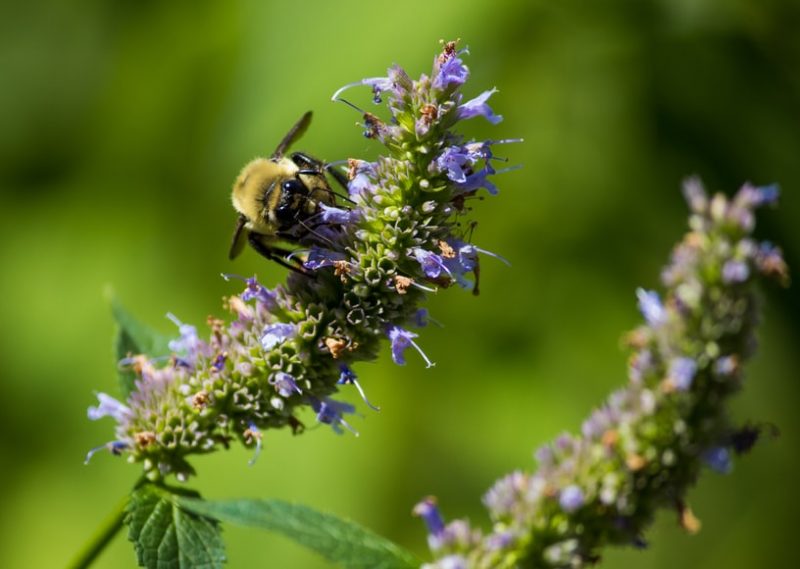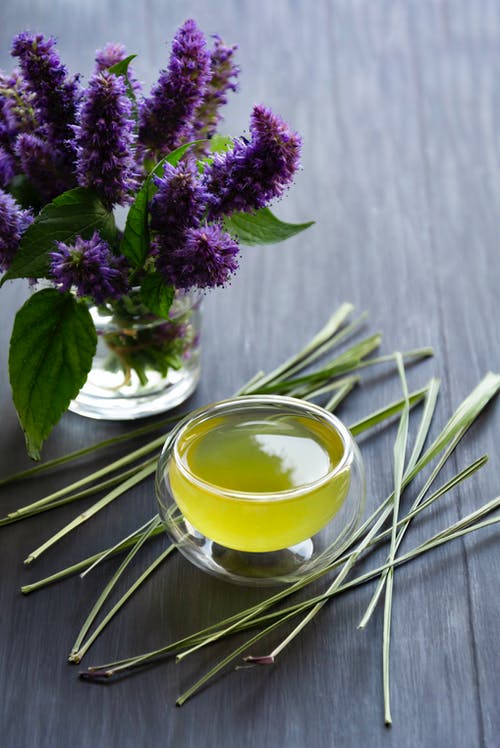Anise hyssop – planting, growing and harvesting
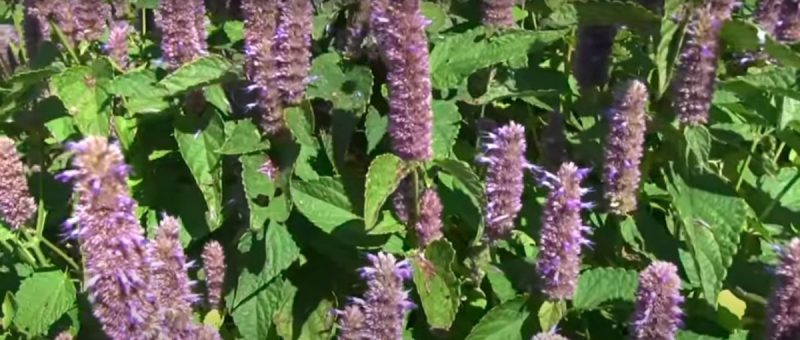
Agastache foeniculum, popularly known as anise hyssop, blue giant hyssop, Fragrant giant hyssop, or the lavender giant hyssop, is a species of perennial plant (but grown in some countries as an annual plant), belonging to the genus Agastache, family Lamiaceae. It is widely cultivated for beekeeping purposes, especially in North America, anise hyssop honey being very popular. In addition, several parts of the anise hyssop are used in various beverages and dishes or for medicinal purposes:
- the flowers and leaves are used to decorate plates, appetizers, desserts and salads;
- the leaves are used fresh to flavor drinks (cocktails, lemonades, syrups, alcoholic beverages);
- dried leaves are suitable for making tea. These have curative and therapeutic effects and can be used internally (by ingestion) or externally (compresses);
- dried and crushed leaves are used as spices, as well as in the manufacture of aromatic pillows and potpourri;
- the roots are used in the pharmaceutical industry.
Description
Anise hyssop is a fast growing plant, that has straight, vertical, slightly boxy stems, with a length of approx. 50 – 100 cm. The leaves are alternately arranged on the stem, have an elongated-oval shape, with a sharp tip and serrated edges. The flowers are purple, small, clustered in straight, upwards-oriented, elongated, terminal spikes. They form from June to July, until the end of September. The seeds are very small, one gram can contain over 1000 seeds.
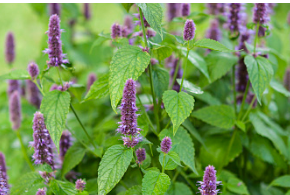
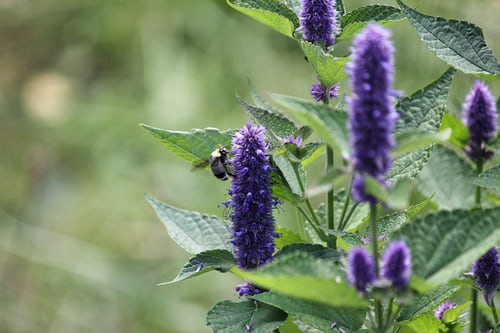
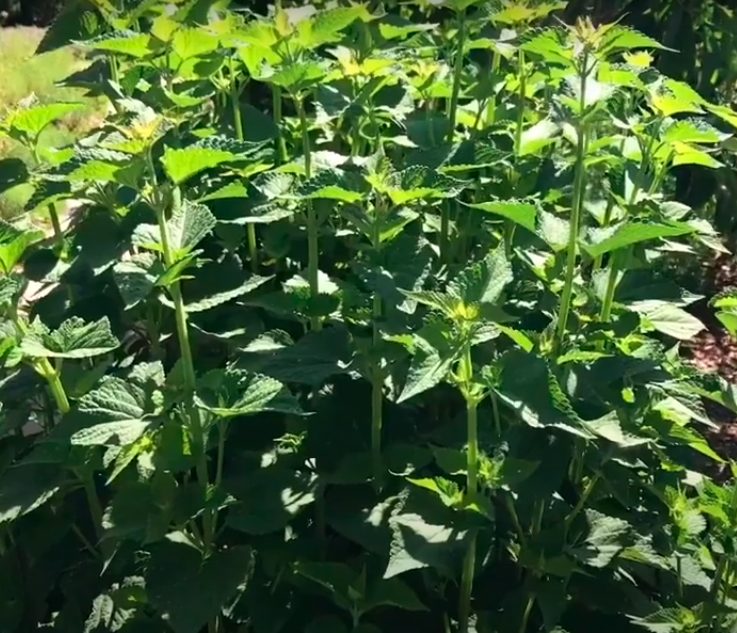
Varieties
Over time, numerous anise hyssop cultivars have been obtained, with various morphological characteristics and accentuated tolerances to various environmental factors. These include aniseed hyssop with white flowers (‘Alabaster’ and ‘Album’), with blue flowers (‘Blue Boa’, ‘Blue Fortune’ and ‘Blue Fountain’), with pink or red flowers (‘Red Fortune’ and ‘Black Adder’), respectively with leaves in various shades of green (e.g. ‘Golden Jubilee’ – with yellow-golden leaves).
Prevalence
It is a species native to North America. Being a species with a lot of pollen and nectar, it is widely cultivated for beekeeping purposes in many regions of the globe. Anise hyssop honey is highly prized, especially in America, having an aniseed flavor. For the consumption of the vegetative parts in various forms, it is often grown in gardens, courtyards, terraces, respectively in flower pots kept indoors. In some regions, it is considered a sacred plant, mentioned in several phrases in the Bible.
Characteristics and biological requirements
Light. It vegetates vigorously in full light or partial shade.
Temperature. Anise hyssop is adapted to the low temperatures during the cold season, withstanding up to approx. -30 ℃. The optimum temperature for the vegetative growth period is between 13 and 30 ℃.
Soil. Anise hyssop is not pretentious in terms of soil conditions, it can withstand most soil types, provided the drainage is good. It prefers slightly acidic or neutral soils.
Water. After sprouting or rooting, it withstands soil dryness well. It vegetates well in damp soils, if drainage is adequate.
Cultivation
The place in the crop rotation. Anise hyssop can be grown in pure crops or in combination with other aromatic or decorative plants.
Fertilizing. For abundant flowering and vigor, specific fertilizers can be applied, according to the instructions on the label.
Recommended products
-
You can find products on a different store
Change Store -
You can find products on a different store
Change Store -
You can find products on a different store
Change Store -
You can find products on a different store
Change Store -
You can find products on a different store
Change Store -
You can find products on a different store
Change Store -
You can find products on a different store
Change Store -
You can find products on a different store
Change Store -
You can find products on a different store
Change Store -
You can find products on a different store
Change Store -
You can find products on a different store
Change Store -
You can find products on a different store
Change Store -
You can find products on a different store
Change Store -
You can find products on a different store
Change Store -
You can find products on a different store
Change Store -
You can find products on a different store
Change Store -
You can find products on a different store
Change Store -
You can find products on a different store
Change Store -
You can find products on a different store
Change Store -
You can find products on a different store
Change Store -
You can find products on a different store
Change Store -
You can find products on a different store
Change Store -
You can find products on a different store
Change Store -
You can find products on a different store
Change Store
Soil preparation. In case of setting up an anise hyssop crop, it is recommended to clean the land of plant debris, followed by maintenance leveling and deep plowing, operations performed in autumn. In spring follows the soil shredding and shaping, respectively the application of fertilizers, if necessary.
Types of propagation. Anise hyssop can be propagated both by germination (from seeds) and by vegetative means, by dividing the plants or by cuttings. Propagation by cuttings is done in its natural environment, where it is a perennial plant, and the plants obtained are usually sterile.
Recommended products
-
You can find products on a different store
Change Store -
You can find products on a different store
Change Store -
You can find products on a different store
Change Store -
You can find products on a different store
Change Store -
You can find products on a different store
Change Store -
You can find products on a different store
Change Store -
You can find products on a different store
Change Store -
You can find products on a different store
Change Store -
You can find products on a different store
Change Store -
You can find products on a different store
Change Store -
You can find products on a different store
Change Store -
You can find products on a different store
Change Store -
You can find products on a different store
Change Store -
You can find products on a different store
Change Store -
You can find products on a different store
Change Store -
You can find products on a different store
Change Store -
You can find products on a different store
Change Store -
You can find products on a different store
Change Store -
You can find products on a different store
Change Store -
You can find products on a different store
Change Store -
You can find products on a different store
Change Store -
You can find products on a different store
Change Store -
You can find products on a different store
Change Store -
You can find products on a different store
Change Store
Sowing. It can be done in the field, starting in March and until the end of May. The seeds can be sown in covered spaces (greenhouses, hotbeds, indoors) earlier in March. The recommended distance between plants is 4-5 cm per row and the same between the rows. The seeds are sown at the soil surface, because germination takes place in partial light conditions, at approx. 1-4 weeks after sowing.
Recommended products
-
You can find products on a different store
Change Store -
You can find products on a different store
Change Store -
You can find products on a different store
Change Store -
You can find products on a different store
Change Store -
You can find products on a different store
Change Store -
You can find products on a different store
Change Store -
You can find products on a different store
Change Store -
You can find products on a different store
Change Store -
You can find products on a different store
Change Store -
You can find products on a different store
Change Store -
You can find products on a different store
Change Store -
You can find products on a different store
Change Store -
You can find products on a different store
Change Store -
You can find products on a different store
Change Store -
You can find products on a different store
Change Store -
You can find products on a different store
Change Store -
You can find products on a different store
Change Store -
You can find products on a different store
Change Store -
You can find products on a different store
Change Store -
You can find products on a different store
Change Store -
You can find products on a different store
Change Store -
You can find products on a different store
Change Store -
You can find products on a different store
Change Store -
You can find products on a different store
Change Store
Maintenance works. They consist, depending on the situation, in the thinning of the crop, the manual control of weeds, the fertilization of the crop and the carrying out of preventive and control treatments with specific fungicides and insecticides.
Diseases and pests. In conditions of high humidity, anise hyssop can be affected by various pathogens, which cause diseases such as powdery mildew, rust, leaf spot or root rot. For prevention and control, specific fungicides are applied. In case of damages caused by pests, systemic or contact insecticides are used.
Harvesting. For fresh consumption, parts of anise hyssop can be harvested throughout the vegetative growth period. The vegetal material destined for drying is preferably harvested at the time of flowering, but before full blooming. Approximately ⅔ of the aerial part of the plant is cut with a knife or scissors, which was previously disinfected. Thus, the vegetative growth starts quickly from the remaining stem, new flowering stems are formed, while leaves and flowers appear after each harvest, until late autumn.
Processing and storage of raw materials
When fresh, aniseed hyssop leaves can be stored for about a week in airtight bags, stored in the refrigerator. To obtain the dry plant material, the aniseed hyssop bouquets are kept hanging with the flowers downwards for 2-3 weeks, in well-ventilated, warm rooms, protected from strong light and excessive moisture. When the plant material is completely dry, it is cut into small pieces, ground or crushed, depending on the use and the consumer’s preferences. The resulting plant material is stored in airtight containers (e.g. jars), keeping its beneficial properties and aroma for approx. 1 year.














































































































































































































































































































































































































































